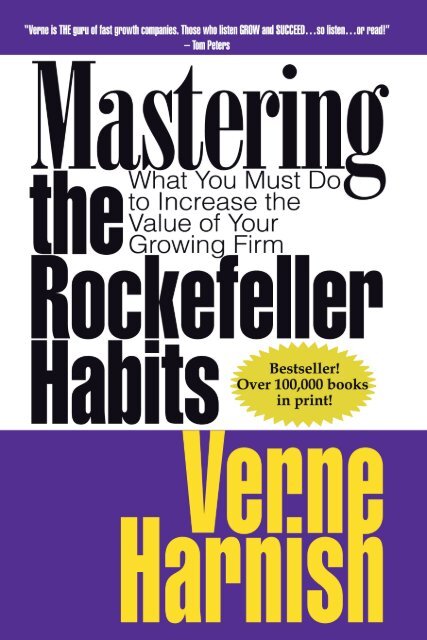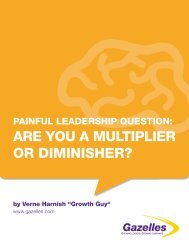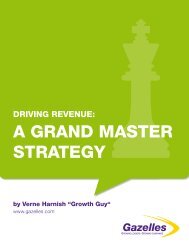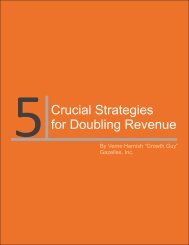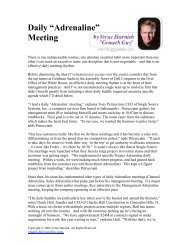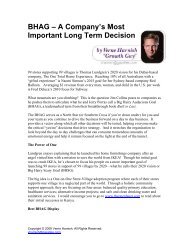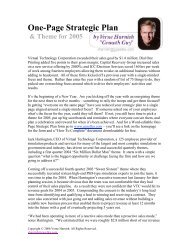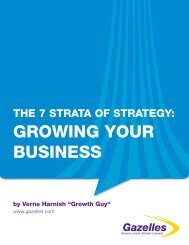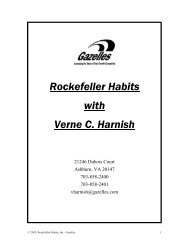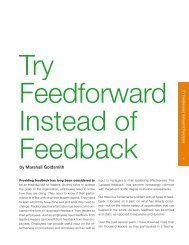english - Gazelles
english - Gazelles
english - Gazelles
You also want an ePaper? Increase the reach of your titles
YUMPU automatically turns print PDFs into web optimized ePapers that Google loves.
CONTENTSINTRODUCTION “How-to” versus “Theoretical” xixOVERVIEWxxiCHAPTER 1 Mastering Growth 1CHAPTER 2Mastering The Right People Doing the RightThings Right 17CHAPTER 3 Mastering a One-Page Strategic Plan 29CHAPTER 4 Mastering the Use of Core Values 43CHAPTER 5Mastering Organizational Alignmentand Focus 53CHAPTER 6 Mastering the Quarterly Theme 63CHAPTER 7 Mastering Employee Feedback 71CHAPTER 8Mastering the Daily and Weekly ExecutiveMeeting 83CHAPTER 9 Mastering the Brand Promise 95CHAPTER 10 Mastering the Art of Bank Financing 105APPENDIX Case Studies 127xviiCopyright 2002 © por Verne Harnish
INTRODUCTION:“HOW-TO” VERSUS“THEORETICAL”Many business authors write a theoretical book and then hearfrom their readers: “But how do I implement this stuff?” I choseto do the opposite and write a “how to” book first. After spendingtwenty years working with and around entrepreneurs, what I’velearned CEOs and executives of growing firms want are ideas andtools they can implement immediately to improve some aspect oftheir business.Tools that Effect ChangeThe term “tools” is a deliberate label and comes from a favoriteBuckminster Fuller quote that embodies our change managementphilosophy, “If you want to teach people a new way of thinking,don’t bother trying to teach them. Instead, give them a tool, the useof which will lead to new ways of thinking.” The tools you are aboutto learn will effect real and positive changes on your business.Real and Immediate Results—Why Believe?Yet why believe these tools are useful? At the front of this book areover 100 CEO endorsements for the tools you’ll be acquiring in thisbook. These are just some of the hundreds of CEOs of mid-size firmsthat have put our tools to work. We know how important authenticreferences are to the leaders of mid-size firms. You need to know thatwhat you’re going to spend your time learning and implementingactually works in real companies like yours.xixCopyright 2002 © por Verne Harnish
Short and SweetLike this introduction, I’ll not waste a lot of words. The material isstructured so you can scan it quickly, pick-up the ideas that matter,and have worksheets you can use to implement those ideas. Exceptfor Chapter 1, which provides an example-rich overview of the applicationof our tools, the rest of the chapters are structured into bitesizedchunks of information with a liberal use of subheadings andsummaries. Enjoy your exploration of these tools.Weekly MusingsIf you like the style and substance of the book, you can receive a veryconcise weekly email of best practices for managing a growing firm —ideas I pick up each week from executives like you. Each weekly emailstarts with a short HEADLINE section providing a one to two sentencesummary of the main ideas, followed by a DETAILS section providingmore specifics for those who wish to dive more deeply into thematerial. Simply send an email to: vharnish@gazelles.com and put“weekly emails” in the subject line. We’ll add you to our growing listof executives.xxCopyright 2002 © por Verne Harnish
OVERVIEW(Reading this chapter provides a summaryfor those executives that want to just scanthe rest of the book)What is the underlying handful of fundamentals that driveeverything else that’s important in business? What is still fundamentaltoday in building a successful firm that hasn’t changed forover a hundred years? Let me triangulate my answer while providingan overview of the book’s key concepts.Tom Meredith, former CFO of Dell Computer, and I were discussinghow the fundamentals in creating a great business are thesame for parenting great kids. Early in his career before Dell, his wifehad encouraged him to attend a Parent Effectiveness Training (PET)program. Reluctantly, he attended. However, what he discovered weresome fundamentals that were just as applicable in business as athome—so much so that he purchased copies for all the executiveswhere he worked.Anyone with children will recognize the fundamentals I’ve summarizedas:1. Have a handful of rules2. Repeat yourself a lot3. Act consistently with those rules (which is why you better haveonly a few rules).About the time my first son was born, as I was studying up on parenting,the book Titan was published. More than a biography of JohnD. Rockefeller, it detailed many of Rockefeller’s leadership and managementprinciples. In fact, it’s a must-read for anyone serious in buildinga successful company. What the book did was confirm three underlyinghabits I have observed are key to the successful management of abusiness and provide what I hope is a catchy label for those habits:xxiCopyright 2002 © por Verne Harnish
Add to this the requirement that you have the ability to becomethe best at implementing this strategy (back to core competencies)and you have a clear idea whether you really have a strategy or notthat will work. Some firms do things that differentiate themselves butit doesn’t really matter to a customer (high quality when the customerjust wants speed) while other firms do things that the customerdesires, but so does all the competition (you’ve just entered the commodityzone). And yet others might have both parts of the strategycorrect from a theoretical standpoint, but fail to execute. Keep thissimple definition of strategy in mind as you read the rest of the book.If we now go back and look at the three sets of fundamentals outlinedin this overview, we find they integrate nicely (and the rest ofthe book provides the “how to” for doing this):1. Priorities—there are a handful of rules, some of which don’tchange much like the core values of the firm and the long-term BigHairy Audacious Goal (BHAG) and others that change every quarterand every week, what I call the Top 5 and Top 1 of 5. It’s thebalance of short term and long term.2. Data—in order to know if you’re acting consistent to your prioritiesyou need feedback in terms of real time data. There are keymetrics within the business that you want to measure over anextended period of time, called Smart Numbers; and there are metricsthat provide a short-term laser focus on an aspect of the businessor someone’s job called a Critical Number. It’s the balance ofshort term and long term.3. Rhythm—until your people are “mocking” you, you’ve not repeatedyour message enough. A well-organized set of daily, weekly,monthly, quarterly and annual meetings keep everyone alignedand accountable. And the agendas for each provide the necessarybalance between the short term and long term.What this book will do is provide you some tools for making thesesimple decisions and then give you the tools for keeping everyonealigned and accountable to those decisions. More specifically:CHAPTER 1: Written differently than all the other chapters (itbecame an article in the September 2001 issue of Fortune SmallBusiness), it provides a dynamic look at the three barriers to growinga firm and the outcomes you can expect if you implement the threeRockefeller Habits. The second half of the chapter provides a straightforwardexplanation of the three barriers to growth.xxivCopyright 2002 © por Verne Harnish
CHAPTER 2: The Right People Doing the Right Things Right modelprovides an overall framework for what decisions need to be madeand in what order to increase the value of your business. It alignsnicely with Jim Collins new research in what it takes to make a goodfirm great.Priorities SectionCHAPTER 3: Mastering the One-Page Strategic Plan helps you getyour long term and short-term vision, metrics, and priorities on a singlepage to aid communication and alignment.CHAPTER 4: Mastering the Use of Core Values provides a way tokeep those “rarely changed” handful of rules alive in the companyCHAPTER 5: Mastering Organizational Alignment and Focus getsspecific about the Top 5 and Top 1 of 5 approach to prioritization.CHAPTER 6: Mastering the Quarterly Theme shows how to place aspotlight on the number one priority to keep it top of mind. DellComputer does this so well.Data SectionCHAPTER 7: Mastering Employee Feedback provides a process forgetting the real time data needed to be “right” about what your prioritiesshould be and to let you know you’re acting consistent tothose priorities. At the end of the chapter, a brief overview of SmartNumbers and Critical Numbers will be provided.Rhythm SectionCHAPTER 8: Mastering the Daily and Weekly Executive Meeting providesspecific agendas for making these vital meetings effective.Reread the various CEO endorsements if you don’t think these meetingsare crucial. And at the end of the chapter, a quick overview of themonthly, quarterly, and annual meetings will be provided.“X” Factor SectionCHAPTER 9: Mastering the Brand Promise provides a simple formulafor narrowing in on the key strategy necessary to dominate yourmarket.xxvCopyright 2002 © por Verne Harnish
Bank Financing SectionCHAPTER 10: Mastering the Art of Bank Financing was co-authoredwith Rich Russakoff. Rich, without a question, is the best in puttingtogether a loan package that gets banks bidding for your business.Ten Case StudiesAPPENDIX: Please DO NOT overlook the Appendix section—some ofthe best material, like in Jack Welch’s latest book, is in the Appendix.Ten firms are highlighted detailing their specific applications of thetools in the book—along with the results they’ve achieved. And thecase studies are rich with marketing, branding, management, and leadershipbest practices you can apply in your business.ImplementationMost of the executives tell us the best way to implement the tools isto purchase a book for every executive and manager and simply gothrough one chapter per month and discuss how the concepts can beapplied to your firm. And several executives are purchasing a book forevery employee. It’s very inexpensive training and provides the rest ofthe employees with some important context for the changes managementare making. It just makes it easier to get buy-in and gain momentum.You can purchase 20 copies or more for $16.95 each or 50 copiesor more for $14.45 each plus shipping. Just go to www.gazelles.comand click on the picture of the book to order.Electronic FormsElectronic versions of the various paper forms I highlight throughoutthe book (like the One-Page Strategic Plan document) are free foryou to download at www.gazelles.com—the link is next to the pictureof the book you see on the homepage of our site.xxviKeep on learning and growing!Verne Harnish, CEO<strong>Gazelles</strong>, Inc.“Increasing the Value of Growing Firms”vharnish@gazelles.comCopyright 2002 © por Verne Harnish
1MASTERING GROWTHWhat CEOs of growing companies knowthat you don’t—and how you can use it tobuild a powerhouse businessExecutive Summary: There are three barriers to growth common among allgrowing firms: the need for the executive team to grow as leaders in theirabilities to delegate and predict; the need for systems and structures to handlethe complexity that comes with growth; and the need to navigate theincreasingly tricky market dynamics that mark arrival in a larger marketplace.This chapter provides the outcomes you can expect if you implement thethree Rockefeller Habits.Back in 1999, Alan Rudy was a disillusioned CEO. “Wasn’t I supposedto be making more money and having more fun, the biggerthe company got?” wondered the founder of Express-Med, amail-order medical supplies firm based in New Albany, Ohio. “I wasangry all of the time,” remembers Rudy. “I had a long weekendplanned to go skiing with my father and two brothers, for the firsttime in ten years, yet I bagged out at the last minute because the businessneeded me to hold things together.” To make matters worse, onMarch 30 of that year he was shown financials by his CFO that estimateda first-quarter profit of $300K, yet two days later, on April 1,his CFO said that they had actually lost $350K. Chuckles Rudy today,“For several hours, I thought it was an elaborate April Fool’s joke. Ikept trying to be a good sport about it, yet it turned out to be true.”Capping it off during that time were employees in fistfights in the1Copyright 2002 © por Verne Harnish
2 MASTERING THE ROCKEFELLER HABITSparking lot, and one employee slashing the tires of another becauseof something said at work. Needless to say “stress was a little high,”says Rudy. Yet, within two years Rudy had reversed the trends and hisseven-year-old firm has become a $65-million winner. More importantly“It’s fun again and we’re making money.”Express-Med is among the elite: of all firms in the United States,only 4 percent survive the transition from a small business to a growingfirm. David Birch, founder of Cognetics and the official keeper ofbusiness growth statistics, calls that 4% “gazelles,” which are firmsthat grow at least 20% a year for four years in a row. These are nothuge, old elephants that are cutting back on employees. Nor are theymice—too tiny to create more than a handful of jobs. NorthAmerica’s gazelles—all of which started as mere mice—now fuel morethan two-thirds of the continent’s economic growth and essentiallyall of its job creation.As the statistics indicate, becoming a gazelle isn’t easy, requiringthe entrepreneur to navigate a specific set of challenges, any one ofthem potentially life-threatening to the business. The good news isthat the barriers to growth are known, and the tools for handlingthem are within the grasp of any entrepreneur. All it takes to makegrowing your business both fun and profitable, at each and everystage of its life, is the discipline to find the right tools and implementthem.No one has learned this better than Molly Bolanos. In 1987,Bolanos had in mind a little muffin company; a bakery-and-deliverybusiness that would cater to offices in downtown Seattle. She was 21and fresh out of college. Bolanos had majored in business, and MostlyMuffins was to be “kind of a case study” to see if she and a partnercould pool their savings and start a company. The startup took fouryears to hit $1 million in revenue. Then the coffee craze hit.Today Mostly Muffins sells 50,000–60,000 items a day, throughStarbuck’s, on airlines and Amtrak, at transit stations, and mostrecently, in grocery stores and food warehouses. The company is ontrack to hit $10 million in revenue this year. In the midst of tremendousgrowth and expansion, the company has managed to add sixpercentage points to its gross margin, while also doubling its cash andtripling the industry average for profits, by following a few businessfundamentals outlined throughout this chapter. And Molly herself isin full bloom as a CEO. “I’ve got my head up and my eyes lookingCopyright 2002 © por Verne Harnish
Mastering Growth 3around for opportunity,” she says, with satisfaction. “I think $30 millionwould be great for us.”Though many might consider Bolanos lucky to have ridden thewave of the high-priced coffee craze, the facts are that she and herpartner made specific and careful choices along the way, the samechoices you must make if you choose to grow your business. “I’vefound that the stages of growth and the issues you face in a companyand as a CEO are very predictable,” says Bolanos. “It’s positivelytextbook.”The “textbook” she’s referring to are the three fundamental barriersto growth outlined in this book that are common among all growingfirms: the need for the executive team to grow as leaders in theirabilities to delegate and predict; the need for systems and structuresto handle the complexity that comes with growth; and the need tonavigate the increasingly tricky market dynamics that mark arrival ina larger marketplace.Delegating to OthersMost entrepreneurs actually don’t like working with anyone, includingtheir own employees! This is the major reason why 96% of allfirms have fewer than ten employees, and a vast majority have fewerthan three. Therefore, the decision to grow isn’t an easy one.Texan Doug Harrison, CEO of a nearly $200 million provider ofmobility aids for the disabled called The Scooter Store, clearly recallsthe shift in thinking that brought his business out of a storefront andup to speed. “I remember like it was yesterday the meeting where wedecided to grow…in the Sunshine Room of the local Holiday Inn.”“We had spent several years struggling to make just our local operationwork. We knew our systems weren’t ready and we knew growingthe business would take us away from our families. But we also knew,once we started making a small profit, that we had a business thatcould grow,” says Harrison. Helping that decision was the threat thatcame from one of Harrison’s so-called friends who saw the sameopportunities and became a potential competitor. It was time to bringon more talent.“One of the first real management concepts that stuck in myhead,” Harrison says, “was that if you can’t afford the people to runthe business for you, then all you have is a job, not a business. It wasCopyright 2002 © por Verne Harnish
4 MASTERING THE ROCKEFELLER HABITSlike somebody turning on the light for me, because I realized that Ineeded to get good people in here to do this for me. I couldn’t keephiring people at as close to minimum wage as possible.” Althoughfriends and family were telling Harrison it was too soon to shell outbig salaries for experienced sales, operations, and financial people, hedid it early in his operation and never looked back. “We went fromtwo locations to five that year, yet we felt we were in better controlof the business.”Delegation is just as crucial as the management thinkers haveclaimed. Harrison knew it was crazy that he was the one decidingwhether the bathroom towels would be plain white or blue-striped.And, as a former petroleum engineer, he couldn’t pretend to haveexpertise in finance or sales. Not only did he have to let go of the nigglingdetails, he had to take the first steps toward reserving for himselfthe role that only the CEO/founder can play, that of leader andvisionary. He needed a managerial structure in place to let him focuson his real job of growing the company.Systems and StructuresWhen the management structure is in place, systems are never farbehind. There’s a reason why: both systems and structure are logicalresponses to complexity, which grows almost exponentially as thecompany expands. Shannan Marty had that experience. She is CEOof Tracer Research Group, a $15 million, Tucson-based tank andpipeline leak-detection company that she co-founded as a two-personoperation in 1983. “By about $8 million or 50 employees, it just getstoo big to keep it all in your head any more, says Marty. “We knewwe had to keep better track of things, so we created positions andbrought in people to do that.”Many of the senior management hires came from much largercompanies like Fina, US West, and Ramada. “They were all incrediblytalented people,” says Marty. “The company would not havebeen able to grow to where we are today without them.” What theybrought with them were the systems that her existing employees,who’d grown up with the company, didn’t have—things like salaryschedules, performance evaluations, information systems, andstrategic-planning processes. However, bringing in outsiders can betricky.Copyright 2002 © por Verne Harnish
Mastering Growth 5“In hindsight, I probably over-hired. Eventually a culture clashdeveloped from the regimented hierarchical communication structuresthey were used to at their mega-corporations. It was stranglingus. Our long-term technical employees were very unhappy andturnover was up.”In addition, Marty says, “I deferred a lot of decisions to this teamand listened to their ideas and accepted them, even when it didn’tfeel right in my gut, because they were the ‘experienced’ ones. In reality,they were no more experienced then I was in an entrepreneurialcompany.” Through mutual agreement and fairly generous severancepackages, Marty eventually replaced the outside hires with the peoplewho were number two behind them, many of whom were the onesoriginally in those positions.Marty says in the future there will have to be more executive-levelhires. “We will need their experience and expertise, again, to help usgrow and to grow our internal team.” However, next time she plansto hire those with experience in a company with 500–1,000 employees,not the mega-corporations like before, and “to keep the informality,open door atmosphere and group problem-solving energywe’ve historically had.”Data Drives PredictionThe ultimate goal of imposing structure and instituting systems is, ofcourse, predictability. Unless a company has the ability to determinewhere it is today and project where it’s going to be this week, thismonth, this quarter, and this year, it’s not on a trajectory for growth.It might not even be on track for survival.At McKinney Lumber in Muscle Shoals, AL, Joe McKinney built tonearly $50 million the small family business he inherited. Much ofthe company’s success is owed to McKinney’s almost slavish devotionto metrics and measurements. McKinney started by training hisentire workforce to understand terms like “gross margin” and “costof sales” through having them operate a lunchtime sandwich business.He also established and popularized an internally understoodCritical Number—a proprietary measurement of plant productivityhe borrowed from another industry and modified to fit McKinneyLumber’s business. The Critical Number tells the entire corporation,day to day, whether there’s profit headed for the bottom line. “TheCopyright 2002 © por Verne Harnish
6 MASTERING THE ROCKEFELLER HABITSidea of always measuring and tracking a Critical Number gives you afirm foundation to know where you are—even if you don’t like theanswer,” chuckles McKinney.It’s the timeliness of the information that really sells the CriticalNumber concept for Mostly Muffins’ Bolanos. “Two years ago, beforewe began tracking our progress daily, we had monthly statementsfrom an accounting firm. It would be the third week in Februarybefore we knew how we did in January. Now, if we blow it in productionor sales one day, we know it the next—and we’re workingwith that team immediately to get them what they need.”Like everything else associated with growth, tracking for predictabilitybecomes ever more difficult as revenues increase and the stakesbecome greater. “When we were measuring for a cake, a measuring cupworked fine,” McKinney says. “But we needed a bigger bowl for a statedinner, and the accuracy had to be there—because a 2 percent error rateon 10 is nothing, but on 1,000, it’s a miss by 20. So the tolerances ofthe system have had to tighten up as the company grows.”Top 5 PrioritiesAs you grow, you must keep the company focused. That’s especiallyhard once you reach the point—usually at about 30 employees—where you can’t personally interact with everyone each day. How doyou keep everyone aligned and reading off the same page? Manygazelles find it useful to set priorities for each quarter—no more thanfive—and then to identify one goal that supersedes the others. This isknown as a Top 5 and Top-1-of-5 priority list.At Carney Interactive—a Virginia-based learning-solutions companythat has gone from $1.9 million to $4.3 million in the past year andhopes to double again this year—founder and CEO John Carney keepsthe Top 5 corporate priorities for the quarter and the company’s eightcore values on 8.5x11 laminated sheets posted inches from his employees’noses. Also on the sheet is a place for each employee to write hisor her own Top 5 priorities for the quarter, aligning them with the company’sTop 5. These postings remind the workforce what’s important—like the priority this quarter to bring projects in on budget (they hadstarted to miss a few) and core values like the need to adapt to rapidchange and wisely manage corporate resources. These postings alsoserve as a simple but effective quarterly performance-appraisal system.Copyright 2002 © por Verne Harnish
Mastering Growth 7But Carney also likes the impression the sheets leave with visitors.“When you walk somebody around the office and everybody has thisfour-color Top 5 and Top 1 of 5 hanging over their desks, you typicallyget, ‘Wow.’” says Carney. “It sends a clear indication to a client, abanker, or a prospective employee that there’s something differentabout how we do business. It gives them another level of comfort thatwe’re staying focused and doing the right things.”Like many gazelles, Carney’s company drives quarterly prioritieswith a theme. Choosing a space motif, Carney first set a “Launch”theme and introduced it at an all-company event held at TheChallenger Center for Space Science Education. “Our current themeis ‘Escape Velocity,’ because as the organization is growing, we’reescaping the old bonds of how we used to do business. It’s like aspaceship escaping gravity—you’ve got to exert a lot of energy to doit.” Each time the 40-member workforce hits a sales goal, there’s atheme-related celebration, with prizes and recognition.While many companies tend to focus their themes on sales goals,it’s important to focus on other areas of the company as well. “Wetend to pick a non-sales goal in our fourth quarter each year,” saysThe Scooter Store’s Harrison. The practice started when he began tonotice that the sales engine was going full-tilt, but elsewhere in theoperation, “the wheels were falling off.” So Harrison established afuturistic “sy-fi” (systems-finance) theme that identified several criticalareas for improvement—including a call for zero errors anddefects, “which was, at that time, ridiculous.” But it was achievedusing a systematic process of tracking errors, gathering data as to whythey were happening, and then using standard quality-improvementmethods for getting to the root cause and solving the problem.The following year, Harrison defined a “Customer WOW” themethat aimed to have customers saying “wow” whenever they interactedwith the company. Harrison himself created the first wow, by ridingan elephant into the employee kickoff meeting. Harrison setanother demanding task in front of the group, one worthy of a wowif achieved. The goal was to cut back the time it takes to get a disabledcustomer’s malfunctioning wheels fixed. “The industry average isseven days, but that’s seven whole days that these people are immobile,”Harrison says. “We got it down to a day.”Hokey as they may sound, quarterly themes are powerful goalmotivators. They focus the entire workforce on that single, overridingCopyright 2002 © por Verne Harnish
Mastering Growth 9about ‘stand-up meetings’ for years and had even tried it,” says AlanRudy of Express-Med. “It just became a test of endurance to stand for30 minutes or more. We often finished just because we were tired,not because the business was getting done.” Today the company’smeetings typically run 10 minutes or less following a routine of justreporting the numbers, going around and highlighting bottlenecksor goal achievements, and being diligent about taking it off-line if acouple of people get involved in problem solving.“It’s true what they say: Routine sets you free. I don’t love structure.It’s just what I have to do, [if] I want to do all the things thatI want to do,” says Rudy. “And a pulse of 200 beats a year from 300hearts in the company, now, that’s a lot of blood flowing in theright direction.”Market DynamicsThe market can make you look smart or dumb, as we’ve all seen thispast few years. Move with a trend and you win; try and buck a marketmovement and it can crush you. For architect Steve Smith of TheLawrence Group Companies in St. Louis, that point came about sixyears into his practice. Specializing in designing and building radiostations (the company also focuses in the healthcare and universityarenas), Smith started witnessing the consolidation of the radioindustry and felt he needed to respond in sync with the market. Yethe was going to have to think differently than his competitors, whoview being an architect as a profession, not a business. “Most architectsthink about designing a building. We decided that we’re aboutdesigning a business, and then finding people that design the buildings—which,in our case, is mostly radio station buildings.”This change of mindset, combined with the rise of the Internet,another market force he’s embraced, has allowed Smith to create a businessmodel that calls for a centrally managed network of architecturalpractices nationwide. So far, The Lawrence Group has expanded to fivedifferent cities, growing from 20 to 125 people and $1.5 million to $16million in revenue since 1996. Smith firmly believes that 20 or 30 locationsare possible. This growth-oriented mode of thinking “is a differentiatorfor us in our profession,” says Smith, “while bringing us thesame challenges everyone faces with growth.” Smith went further thanthinking big. He conceived a set of core values in his business (seeCopyright 2002 © por Verne Harnish
10 MASTERING THE ROCKEFELLER HABITSChapter 4, Mastering the Use of Core Values) and put in the systems,metrics, and structures necessary to deal with the complexity. He’s builtthe culture and discipline that, in 2000, got The Lawrence Group voted“the best place to work” in St. Louis for his size category of firms.With growth, market pressures increase and strategic decisionscome with higher stakes. At $10 million and higher, CEOs often feeltheir attention is being pulled inside the business just when theymost need to be focusing on what’s happening outside in the market.McKinney of McKinney Lumber says that hard experience has taughthim that growth decisions are dangerous if you don’t have a good feelfor what’s going on both inside and outside the business.“You have to understand where you are within your own industryand know that you’ve got everything handled before you try to stepup to the next level, because a fall off the side of that mountain canbe deadly,” McKinney says. “There are points along the way whenyou’ve got to get across the entire canyon to the next growth plateauin one jump. You don’t get two jumps. But maybe you don’t have tojump at all. Maybe the tigers on this side aren’t as mean as the lionson the other side.”The plain truth is that growing a gazelle can be so painful at certainstages that many an otherwise successful CEO has looked to anexit strategy. Shannan Marty was sufficiently distressed with TracerResearch Group’s flagging fortunes just last year that she was ready tosell—until a technological breakthrough captured the markets attentionand convinced her and her partner to abandon the sale. Back in1999, when Express-Med was struggling, Alan Rudy was consideringeither quitting or scaling back the business to a point where it mightseem fun again.Grow ThyselfBut tough times offer good CEOs the opportunity to look at themselvesand their role with new eyes. Molly Bolanos of Mostly Muffinssays increased managerial sophistication through executive trainingand coaching has allowed her to re-evaluate and re-define her role.“I’ve realized that my unique ability is connecting with people—sellingwho we are and where we’re going. I don’t have to manage thenumbers anymore, because I have a structure doing that for me. Thepotential now seems endless. Now, when I think about how to growCopyright 2002 © por Verne Harnish
Mastering Growth 11the company, the key strategic question is, ‘Who do I need to be, andwhat do I have to do to get there?’”With consulting help, Rudy realized he had been giving his middlemanagers too little authority and too many confusing instructions.He backed off, took some training to work on his personal style, andgave many of his day-to-day oversight functions to a newly hiredpresident. Thanks to the management structures he’s put in place,along with the measurements and meetings that keep it all humming,Rudy is free to work on new projects and acquisitions.“It’s absolutely amazing how all of this has changed our company,”he says. “Today I have time to think and try things. This is my truetalent—listening to what people need, talking to competitors andcustomers, and adjusting my business accordingly. When I am focusingsolely inside the company, I cannot move the company ahead. Iam much more the CEO than I was before.”Today, Rudy is back on an annual growth path of more than 50 percent,creating the kind of gazelle that is fun, and generating returns forhimself and the economy—which add to the rewards of growing abusiness. This, too, is within your reach if you choose to make the leap.Barriers to GrowthThere are roughly 23 million firms in the US, of which only 4 percentget above $1 million in revenue. Of those firms, only about 1 out of10, or 0.4 percent of all companies, ever make it to $10 million in revenueand only 17,000 companies surpass $50 million. Finishing outthe list, the top 2,500 firms in the US are larger than $500 million andthere are 500 firms in the world larger than $11 billion. As organizationsmove up this growth path they go through a predictable seriesof evolutions and revolutions (Figure 1-1).Let’s review the three barriers that prevent firms from movingalong this path: lack of leadership, lack of systems and structures, andmarket dynamics.LeadershipAs goes the leadership team goes the rest of the firm. Whateverstrengths or weaknesses exist within the organization can be tracedright back to the cohesion of the executive team and their levels ofCopyright 2002 © por Verne Harnish
12 MASTERING THE ROCKEFELLER HABITSFigure 1-128 MillionFirms> $10 million.4%> $50 million17,000< $1 million96%> $1 million4%trust, competence, discipline, alignment, and respect. The two mostimportant attributes of effective leaders are their abilities to predictand to delegate. Within the category of prediction I include the abilityto set a compelling vision that anticipates market movements.Leaders don’t have to be years ahead, just minutes ahead of the market,the competition, and those they lead. And the ability to accuratelypredict revenues and earnings is the ultimate test of leadershipfrom the perspective of Wall Street and the public markets.If we look at the second attribute of effective leadership, the abilityto delegate, we can understand why most firms have fewer thanten employees. Getting others to do something as good as or betterthan yourself is one of the hardest aspects of leadership, but necessaryif you’re going to grow the business. Thus most entrepreneursprefer to operate alone or with a couple of people. To get to the levelof ten employees, the founders must at least begin to delegate thosefunctions in which they are weak. As the organization approaches 50employees, whatever is the strength of the top leader can become theweakness of the organization. From 50 employees up, it’s then a matterof adding various layers of mid-level and frontline leaders. Thesuccess of the firm is determined by the extent to which the seniorleadership team can grow the next levels of leadership, and teachthem in turn to predict and delegate effectively.Copyright 2002 © por Verne Harnish
Mastering Growth 13Successful delegation starts with choosing the right person. Keep inmind the rule that one great person can replace three good people.With the right people, delegation is a four-step process to pinpointwhat they are to do, create a measurement system for monitoringprogress, provide feedback, and then give out appropriately timedrecognition and reward.Systems and StructuresAs an organization grows it becomes more complex. There are mathematicalformulas for complexity that show that as you move fromtwo products, employees, or sites to four products, employees, orsites, your complexity increases by a factor of 12. It’s a force ofnature: the lowly amoeba can do everything it needs with one cell,but as the number of cells increase the organism begins to developsubsystems—for feeding, elimination, circulation, procreation, etc.The same is true for companies. Increases in complexity leads tostress, miscommunications, costly errors, poor customer service, andgreater overall costs.To keep from being buried, an organization must put in placeappropriate systems and structures. When you go from two employeesto ten, you need better phone systems and more structured space.If your company goes to 50 employees, you still need space andphones, but suddenly you need an accounting system that showsmore precisely whether, which, and how projects, customers, or productsare actually making money. From 50 employees (or from $10 to$50 million in revenue), typically all the information-technology systemsneed to be upgraded. And above $50 million, you get to revampthem again, as the organization tries to tie all systems to one databaseof customers and employees.Considering structures, as the firm grows it becomes increasinglyimportant to pay attention to organizational-structure issues. The keyis to think in terms of three types of organizational charts. The firstlooks like what most of us know as the standard hierarchical organizationalchart. I call it an accountability chart. The second type isactually a set of organizational charts that map work process or workflow. The third, the Almost Matrix, maps the relationships betweenorganizational functions and the various business units that begin toform as the organization grows.Copyright 2002 © por Verne Harnish
14 MASTERING THE ROCKEFELLER HABITSAccountability charts: A company will often become stuck or experiencea lot of miscommunications and balls getting dropped whenthere isn’t clear accountability established within an organization. Allprojects, line items on an income statement, priorities, and processesmust ultimately be owned by a single person, even though theremight be hundreds of people who have some kind of sub-accountabilitiesand responsibilities in seeing something completed.There are two basic rules accompanying the creation of anaccountability chart. First, there can be no “to be determined’s” onthe chart. If you can conceive of a position, put someone’s name init, even if his or her only accountability is to make sure the positionis filled. Organizations often place the term “acting” in front of thetitle of someone filling a spot until it can be permanently filled.Second, there are always a few people in the organization whoshouldn’t be leading other people, yet are considered senior in theorganization. In this case, a few “off org chart” positions are advisable.Work process charts: Because the accountability chart can’t captureall the interactions necessary to run a business without a mass ofdotted lines running all over the chart, it’s better to keep theaccountability chart clean and then establish four to nine work flowcharts representing the critical processes that flow through the organization.These processes might include how you acquire a customer,how a project moves through the organization, how employeesare selected and trained, and how customers are billed and paymentscollected. It’s advisable to take the one process per quarterthat seems the most dysfunctional and clean it up. Processes are likegarages and hallway closets, which become messed up over time andrequire regular attention.Almost Matrix: This chart shows the relationships between organizationalfunctions and the business units that form as the organizationgrows. These units begin to feel and act like separate businesseswithin the business. They can be organized around product lines, customerniches, geographical locations, or business units acting aswholly owned subsidiaries of the parent company. Conflicts oftenarise between the functional leaders, like the VP of Sales andMarketing, and the business unit heads who have sales people drivingtheir revenue. The key question is, to whom do the sales peoplereport in the organization? This kind of tension often leads to a reg-Copyright 2002 © por Verne Harnish
Mastering Growth 15ular cycle of centralizing and then de-centralizing certain functionswithin the organization, which can consume a lot of energy. Ourposition is that most people should be accountable to the businessunit leaders; the role of the functional leader is one of coaching andbringing best practices into the organization. It’s a complex issue thatrequires some real thought and expertise.Overall, it’s important to think in terms of multiple organizationalcharts and to assign accountability to someone to make sure thevarious charts are being updated.Market DynamicsThe market makes you look either smart or dumb. When it’s goingyour way, it covers up a lot of mistakes. When fortunes reverse, allyour weaknesses seem to be exposed. And there’s a counter-intuitiveaspect of growing a business: when the firm is under $10 million inrevenue and just a little more focus internally on establishing healthyorganizational habits would pay off in the long run, you have a tendencyto focus mostly externally. In turn, as the organization passes$10 million, the organizational complexity issues start drawing theattention of the senior team inward at a time when it’s probably moreimportant for the team to be focused more on the marketplace. Thisis when it’s useful to have outside assistance in dealing with internalissues so you can remain focused externally.Going back to the evolution and revolution chart and consideringthe basic measures of a business—revenue, gross margin, profit, andcash—there is an important sequence of things to focus on. Betweenstart-up and the first million or two in revenue, the key driver is revenue.The focus is on getting interest in the marketplace interestedin you.As for cash, the entrepreneur has to rely on self-funding or friendsand family in the very beginning.Between $1 million and $10 million, you add to your focus on revenuethe cash concerns you had been putting off. Since the organizationwill typically grow more and faster during this stage than anyother, cash will be rapidly consumed. In addition, in this stage theorganization is experimenting a great deal to figure out what its specificfocus and position in the market should be. These experimentscan be costly.Copyright 2002 © por Verne Harnish
16 MASTERING THE ROCKEFELLER HABITSAs the organization passes $10 million, internal and external pressurescome to the forefront. Externally, the organization is now onmore radar screens, alerting competitors to your threats. Customersare beginning to demand lower prices as they do more business withyour organization. At the same time, internal complexities increase,which cause costs to rise faster than revenue. All of this begins tosqueeze an organization’s gross margin. As gross margin slips a fewpoints the organization is starved of the extra money it needs toinvest in infrastructure like accounting systems and training, creatinga snowball effect as the organization passes the $25-million mark. It’snow critical that the company maintains a clear value proposition inthe market to prevent price erosion. At the same time the companymust continually simplify and automate internal processes to reducecosts. Organizations successful at doing both can actually see theirgross margins increase during this stage of growth.By $50 million in revenue an organization is expected to haveenough experience and position in the marketplace that it can accuratelypredict profitability. Not that profit hasn’t been important allalong as the organization grows. It’s just more critical at this stagethat an organization can predict profitability, since a few pointswings either way represents millions of dollars. This brings us fullcircle to the number one function of a leader, the ability to predict.The fundamental journey of a growing business is to create a predictableengine for generating wealth as it creates products and servicesthat satisfy customer needs and creates an environment thatattracts top talent.In summary, growing a business is a dynamic process that requiresa shifting set of priorities as the leadership team navigates the predictableevolutions and revolutions of growth. Continuing to growthe capabilities of leadership throughout the organization; installingsystems and structures to manage increasing complexities; and movingahead with the market dynamics that impact the business, are fundamentalto successfully growing a business that’s fun and profitable.Copyright 2002 © por Verne Harnish
2MASTERING THERIGHT PEOPLE DOINGTHE RIGHT THINGSRIGHTOptimize Your Human Capital!Executive Summary: This chapter provides an overall framework for whatdecisions need to be made to increase the value of your business. It alignsnicely with Jim Collins’ new research in what it takes to make a good firmgreat. And it provides a framework for applying the three Rockefeller Habits,which will be covered in this chapter.There are three basic decisions an executive team must make:1. Do we have the Right People?2. Are we doing the Right Things?3. Are we doing those Things Right?The Right PeopleFor 2000 and 2001, Fortune magazine surprised the business world bychoosing The Container Store as #1 of the “Best Companies to Work17Copyright 2002 © por Verne Harnish
18 MASTERING THE ROCKEFELLER HABITSFor,” beating out standards like Southwest Airlines, GE, Microsoft andSAS. A 25-store retail chain that sells products that help you organizeyour home, it was launched 24 years ago by Kip Tindell and GarrettBoone, who were still leading the firm at the time this book was written.If you go to their Website, www.containerstore.com, and click onCareers, you’ll see their hiring philosophy. In essence, they firmlybelieve that one great person can replace three good people.They also pay their people 50 to 100 percent more than typicalretailers, which can be done if you have proportionately fewer people.They also provide them with over 200 hours of training their firstyear versus the ten hours standard in the retail industry. Not two tothree times the amount of training, but over 20 times the amount oftraining. And, again, this isn’t GE I’m talking about. This is a firm inthe retail business where the majority of the employees are collegestudents who aren’t likely to make a career out of working there.Obviously, a key to The Container Store’s success is that they havethe Right People. And their formula is fairly simple; fewer people,paid more and given lots of training and development. Worried aboutspending all that money on training people so they can go elsewhere?The research is definitive that training and development increasesloyalty. Besides, what’s the alternative? Do you really want the peopleyou have right now to not be the best trained for the job theyhave to do?The first question you must ask is “Do I have the Right People?” Anda quick way to discern the answer is to ask yourself if you would enthusiasticallyrehire each person on your team if given the opportunity.The second question to ask, especially regarding your executive teamand other key employees, is whether you think they have the potentialto be the best in their position three to five years from now. (By theway, you might have the Right People, just in the wrong position.)When you have “A” players, it makes all the difference in the world.Hiring—Selling the VisionBooks have been written exclusively on the subject of hiring. (I’llmention an important one later in this chapter). However, there area few basics to hiring that can go a long way toward making sureyou’re getting the right people. The first is to understand that hiringis a numbers game. The firms that get the best people tend to get aCopyright 2002 © por Verne Harnish
Mastering the Right People Doing the Right Things Right 19lot of people applying for each position and the general quality of thepool of people is so high that if you had to decide by throwing a dartat a list of potential employees you likely would make a great decision.And this is why a firm that has established a stellar reputationin its industry (or even in a particular town if you primarily hire locally)is able to continue to hire stellar people.So ask yourself the question: did we get a lot of high-quality peopleto apply for the last position we hired, especially if it was an executiveposition? This applies whether you used a headhunting firm (dothey have access to a large pool of quality applicants?) or you’re drivingthe process yourself. Generally speaking, you or your headhuntershould have an initial pool of 50 high-quality people tochoose from. If you’re relying on your network of contacts to findsomeone, are you reasonably sure they are in contact with a largepool of high-quality people? Remember, “A” people tend to surroundthemselves with “A” people, so go only to your “A” network offriends. I’m very serious about this last comment.A useful tool you can use to access a high-quality pool of applicants,or any source of people—for example, for funding or gettinga referral to a top executive at a potential customer—is to make asimple Top 10 list. I’ve done this with many CEOs looking to fill keypositions. Take out a piece of paper and write down at least 10 people(20 is best) you could e-mail tomorrow who have contact withthe kinds of people you want. Then put together a two-paragraphsummary describing your firm, the position, and the kind of personyou want to hire. Make it a point to call the people on your list asquickly as possible and let them know you’re sending the summaryby e-mail. Follow-up a week later to see if they know anyone or ifthey at least know someone who might know someone. This, by theway, is essentially what headhunters do, so if you’re unwilling to dothis, hire a headhunter.Another important basic for hiring, whether you’re sending out ane-mail, placing ads, using a headhunter, or utilizing several of theonline services like monster.com, is to make sure you’re truly sellingthe company and its vision. You need to market your firm to potentialemployees with the same vigor you use to attract potential customers.As shown in the following example, I had a client that simply changedtheir ad from the first one to the second one and increased the numberof applicants three-fold:Copyright 2002 © por Verne Harnish
20 MASTERING THE ROCKEFELLER HABITSEMPLOYMENT AD—Exceptional opportunity! Rapidly growing promotionalmarketing agency with Fortune 500 clients seeking:ACCOUNT EXECUTIVE (description only delineating qualifications).versusWHEN WAS THE LAST TIME YOU HAD FUN AT WORK? It’s a greattime to join our promotional marketing agency team. Get all thebenefits of working with Fortune 500 clients in a small-agency environment.Not only do we take pride in what we do, we have FUN.Your creativity & energy are what we need. PROMOTIONS MAN-AGER description (delineating what you’ll do) and ACCOUNT EXEC-UTIVE description. Enjoy coming to work. Send resume to_______.If using a headhunter, work with them to create a persuasivedescription of the company and position they can share.The Selection ProcessInterviewing is the most perilous part of the process because there isactually a slight negative correlation between who you would likelyhire based on an interview and whether they would be a great fit withyour firm. Given how badly many people conduct interviews, youwould be better off throwing darts at a list! The only type of interviewthat is effective is a behavior-based structured interview. BradfordSmart is the expert in this field. I highly recommend his latest bookTopgrading. It’s very “how-to.”Testing is considerably more accurate and objective than interviewingand should always supplement the interview process. Manyof the best-run firms have their applicants, especially potential executivesor managers, submit to several hours of formal testing. Leastimportant of the tests, though the one everyone seems to use, is thestandard personality test. Don’t mess around in this arena—use professionalsto help with this process. My firm recommends to allclients Bartell & Bartell, (814-861-6606) for manager and executivehires. It will cost you roughly $600 per candidate, so we recommenddoing the testing on the top three picks. And you’ll need to haveyourself tested so they can check for compatibility. For the rest ofyour hires we recommend Bigby Havis & Associates’ online testingproducts (972-233-6055). Again, you need to have yourself tested.Copyright 2002 © por Verne Harnish
Mastering the Right People Doing the Right Things Right 21I’ve interviewed candidates in the afternoon, had them go online inthe evening and complete tests and had the results available immediatelyonline so the decision can be made the next morning.The most important thing you’re trying to discern in the selectionprocess is the candidate’s fit with your culture. See Chapter 4,Mastering the Use of Core Values for more on this. If you’ve discoveredyour core values properly and they are alive in your organization,the number one reason an otherwise-qualified candidate justwon’t make it in your organization is his or her misalignment withyour core values. A close second is whether they have a positive ornegative outlook, which can be discerned primarily through testing.For entrepreneurial companies, a positive outlook is a requirement.Testing for emotional maturity also ranks high on my general recommendationlist as an important “go, no go” factor in the hiring decision.Last, I recommend and use a variation of an assessment-centerapproach. Outline on a piece of paper three or four business challengesyou’re expecting candidates to face when hired and then givethem 30 minutes to an hour to work through how they would handleeach. Then spend another 30 minutes working through their solutionswith them to see how they think and to get a sense how youmight work together. If nothing else, when I’ve employed this techniqueI’ve picked up even from the candidates I’ve not hired somegreat insights into business challenges I’m facing. One time I evencontracted with a candidate to do a special project, even though thecandidate knew I wasn’t offering a permanent position.Though not always possible, the best way to select the Right Personis to have someone work with you for several weeks doing the workyou’re expecting him or her to do. For frontline hires, “temp-toperm”placement firms are popular because they allow you to testdrivethe candidate. For management hires, see if they can work withyou in the evenings on a consulting basis. Several of my venture capitalfriends have found, especially when hiring a top executive, thatnothing substitutes for simply working alongside the final candidateover an extended period of time dealing with the tough issues facingthe business. That’s why promoting from within and hiring peopleyou’ve worked with in the past are so effective.Overall, getting the right people in the right positions is the firstand most important job of the CEO and executive team. Also importantis getting the wrong people out as quickly as possible—thoughCopyright 2002 © por Verne Harnish
22 MASTERING THE ROCKEFELLER HABITSfor many reasons this is one of the hardest aspects of running a business.It’s why you need a strong executive team and a top-notch advisorso they can tell you when you’re blind to the obvious facts. Oftenyou just can’t see the problem people yourself.Right Things ModelThe Right Things Right model (Figure 2-1) illustrates the fundamentaldecisions, relationships and functions of a business. The three ovalson the left side of the model show the Right Things; the three ovalson the right show how to do Things Right. Every business theory canbe mapped onto the model; it provides a framework with which tointegrate various business theories. It’s also a useful model to helpexplain to all employees the fundamentals of business. Lastly, itserves as a useful tool for choosing quarterly priorities.The key questions on the Right Things side of the model are “Doyou have a viable economic model?” Or, more bluntly, can you evermake real money doing what you’re doing? Do you have a product orservice that enough customers value to make a viable business? Andhave you determined the X factor that you can control that differentiatesyou from the competition, matters to customers and providesyou an advantage in the marketplace? Can you be the best in yourchosen sandbox?The key questions on the Things Right side of the model are “Doyou have the management practices and processes to take advantageof the market opportunity you’re pursuing?” Do you have the habitsand disciplines in place to maintain your competitive advantage? Isyour organization structured properly to maximize the productivityof the employees? Can you deliver a consistent service or productoffering?Moving down through the model, you know you’re doing the RightThings when revenue or market share—or both—are growing at twicethe market. Though most executives feel their business is unique, youcan always approximate the growth of your industry segment fromvarious sources. And if your industry segment is in decline, are yougrowing at least twice as fast as your nearest competitor as you divideup what’s left as others exit the market? You know you’re doing ThingsRight when your gross margins and profitability are at the top of yourindustry. Again, you can approximate these numbers.Copyright 2002 © por Verne Harnish
Mastering the Right People Doing the Right Things Right 23Figure 2-1Right Things RightLead PeopleManage ActivitiesCustomersSellReputationProductivityMakeKeepEmployees Shareholders or GoodBuyRecordsGet, Keep, GrowBetter, Faster, CheaperAccountabilityScheduleAction StepsGoalsTargetsPurposeCore Values©2001 <strong>Gazelles</strong>, Inc.Copyright 2002 © por Verne Harnish
24 MASTERING THE ROCKEFELLER HABITSThe Right Things side requires bold leadership able to make a fewkey decisions about strategy and direction, especially when the businessneeds to make an abrupt turn in the market—like Microsoft’sdecision to shift significant resources to the Internet or Bill Gates’decision to step down as CEO. The Things Right side requires capablemanagement that can maintain healthy disciplines and habits.Interestingly, much of what is good management is being augmentedby and will eventually be replaced by technology so that the peoplein the organization can focus more on leading instead of managing.Our firm has created some executive management automationsystems that are already heading down this path.If you then consider that a business is simply “people” doing“activities,” the model supports a familiar notion that you lead peopleand manage their activities—you don’t manage people. Think ofthe parenting approach that says you love the child while beingtough on their inappropriate behaviors, i.e. “son, you’re good, whatyou did is bad” versus “son, you’re bad.” It’s important to separate theperson from their activities. While continuing to inspire peoplethrough your leadership skills, you must also be diligent about holdingpeople accountable to results. In fact, you might have to lovesomeone enough to let him or her go. (I tend to prefer the phrase“freeing up your future!”)This is where the model gets more explicit. The Right Things siderepresents the people and relationships involved in any business; theThings Right side represents the activities or transactions that occurwithin a business to deliver consistent products and services to themarket. The three fundamental groups of people that interact in abusiness are Customers (including suppliers), Employees (includingsub-contractors), and Shareholders—which models closely theBalanced Scorecard system UPS and other firms have adopted.(There’s a book called The Balanced Scorecard for those interested—itessentially supports the notion that a leader’s success is defined ashaving satisfied all three stakeholders, not just one or two.) The threefundamental activities at the heart of all businesses are the functionsof Making or Buying something, Selling something, and KeepingGood Records. This mirrors the primary top executive functions ofCOO (make or buy), VP Sales and Marketing (sell), and CFO (records),with the CEO serving as their leader. Though the titles may vary, it’sthis fundamental troika serving under the CEO that makes an effectiveorganization.Copyright 2002 © por Verne Harnish
Mastering the Right People Doing the Right Things Right 25Taking the model further, on the Right Things side you strive toachieve three outcomes: get, keep and grow all three relationships. Todo this, you need to figure out what basic needs you can fill for a certaingroup of customers in a way that differentiates you from thecompetition and then what competencies your people need to meetthose needs so that value is created for the shareholders. I was specificin using the term “needs” versus “wants.” Customers can bankruptyou with their wants, wants, wants while a laser-focused competitorcan come along and deliver on a more important need and steal yourcustomers. Ultimately, this boils down to one overarching concept—the fundamental need to build a great reputation with all threestakeholders. You know you have a great reputation when it gets easier,instead of harder, to get, keep, and grow each of the three relationshipsOn the Things Right side, the organization strives to achieve threeadditional outcomes: doing each of the activities better, faster, andcheaper. The primary objective is to continue to lower the costs ofdelivering your products or services relative to the sales price andimprove the value proposition so you can maintain your prices relativeto the competition to increase profitability. The right side of themodel encapsulates the classic, “buy low, sell high, and keep goodrecords” fundamentals of business.Looking at the Right Things Right model from a pure accountingperspective, the left side of the model represents the balance sheet ofthe business, delineating who owes and who owns what. The bottomline of a balance sheet is net worth—a measure of value created forthe shareholders. The right side of the model represents the incomestatement (P&L), delineating the revenues and expenses with a bottomline of profitability.The six circles of the Right Things Right model balance on thevision of the company, as represented by the Planning Pyramidshown at the bottom of Figure 2-1. This will be covered in Chapter3, Mastering a One-Page Strategic Plan. It’s the vision of the company,from its core values to its specific accountabilities, that gives afocus to the specifics of each of the six circles—exactly who are thecustomers, employees, and shareholders, and exactly what are theactivities in which the business will engage. What’s important tonote at this point is that there is a constant balancing act betweenthe left and right sides of the model; between driving revenue andCopyright 2002 © por Verne Harnish
26 MASTERING THE ROCKEFELLER HABITSmaking sure the business is profitable; between having enough peopleand having enough activities for those people; between protectingthe reputation of the firm and increasing the productivity of thefirm. Business is a constant process of balancing priorities, which iswhy the top part of the model balances on the pinpoint vision of thecompany.Putting the Model to WorkIn addition to a general framework for business, there are three specificuses of the model relative to the Rockefeller Habits:Rockefeller Habit # 1—PrioritiesA starting point to figuring out the number one priority for any particularquarter is to consider the six circles as potential priorities andchoose the one on each side that needs the most attention at thatmoment. Be sure to specify whether the left-side driver is get, keep,or grow, and whether the right-side driver is better, faster, or cheaper.As an example, this quarter the top priority might be “increase by25 percent (grow) the business we’re doing with our top four customers”(choosing the Customers circle on the left) and “reduce thetime by 50 percent (faster) it takes to properly bill our clients”(choosing the Keep Good Records circle on the right). Even thoughyour firm may have issues within all six areas, you can only advanceone of the areas on each side at a time. And because they are allinterconnected, by giving momentum to one you provide momentumto all. Selecting a specific area is one of the tougher disciplinesto maintain because the tendency is to try and work on all the areassimultaneously. However, leaders find that when they focus everyone’senergies around one area, it gets fixed much more quickly. Twovisual analogies are helpful. First, think of the six circles as spinningplates on sticks, like you might have seen on an old Ed Sullivan rerun.At any one time, one of the plates of the three on either side isspinning slower than the other two and needs your attention.Another way to think of the six circles is as balls being juggled in theair. As a juggler moves the balls higher and higher, he or she does itone ball at a time. The same situation applies to growing a business.It’s a process of hiring employees, rounding up customers, then mak-Copyright 2002 © por Verne Harnish
Mastering the Right People Doing the Right Things Right 27ing sure you have cash to support the growth, as you hire moreemployees…. The process is never-ending.In addition, it’s very important to be clear about who is accountablefor each circle in the model. Who is accountable for getting customers?Who is accountable for keeping shareholders happy? Who isaccountable for making sure the sales engine (the Sell circle) is functioningproperly? Going through each of the six circles and their drivers(get, keep, grow, and better, faster, cheaper) and making sure theaccountabilities are clear is one of the more powerful and aligningactivities I’ve worked on with executive teams.Rockefeller Habit #2—DataTo monitor the progress of the business daily and weekly, and toaccurately predict how the next few months are likely to turn out,you need metrics about all six areas of the business. For mid-marketfirms, the weakness on the left side of the model is having the samekind of accurate and timely feedback from customers that youdemand from accounting. On the right side of the model, mid-marketfirms tend to be weak in having accurate sales funnel data, primarilybecause the sales side of the organization tends to resist measurement,except for the top line.Rockefeller Habit #3—RhythmIn figuring out with whom you need to have various weekly meetings,the six circles provide guidance. On the right side of the model,it’s crucial that operations, sales, and accounting each has its owndaily and weekly rhythms. In turn, it’s important that the executiveteam have some rhythm in terms of meeting with customers andemployees. And if you are a public company, you have an entire newset of rhythms that revolve around the shareholder circle.Organizational StructureBesides giving substance to the Rockefeller Habits, the six circles provideguidance for the changing organizational structure necessary tohandle growth. Around $10-million in revenue, the three fundamentalfunctions represented by the three circles on the right beginCopyright 2002 © por Verne Harnish
28 MASTERING THE ROCKEFELLER HABITSto split. The Sell circle splits into separate sales and marketing functions,requiring different personalities to head up each. (As a sidenote, the key measurable for marketing or business development islead generation.) The Make or Buy circle splits into separate operationsand R&D functions (or their equivalents—all firms should havesome form of R&D). And the Keep Good Records circle splits intoseparate accounting and finance departments. On the left side of themodel, growing firms tend to develop more specific functional areasfocusing on employees, (HR is the old term); focusing on customers,whereby the organization starts to create customer-focused teams tocomplement possible product-focused teams; and focusing on shareholderswhere public firms develop specific shareholder-relationsdepartments.In summary, the Right People Doing the Right Things Right modelencompasses the fundamental decisions leaders must make to successfullydrive any business. The rest of the book provides specifictools for addressing each of these areas.Copyright 2002 © por Verne Harnish


